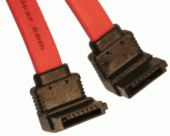So the data is your HDD will not loss unless you delete it, format the HDD or hard disk drive spoilt. What's more, if computer viruses infect your system, they can scramble your valuable data, making your hard disk function abnormally, if at all. So always take extra care when working with your hard disk; if you don't, all the data can very suddenly and quite painfully become inaccessible.
Below are the pictures of a physical HDD (left) and a HDD that cover being open (right):
Note: Please do not remove the cover of your HDD as this will damage the disk.
HDD Architecture
Most hard disk drives consist of spinning platters of aluminum, glass or ceramic that are coated with a magnetic media.
Below is a picture of what the inside of the hard disk drive looks like. The Hard disk drive has four main components. The head actuator controls the head arm, which reads the data off of the disk platter. The chassis encases and holds all the hard disk drive components.
HDD Capacity and Size Information When purchasing a hard disk drive, the term megabytes, gigabytes or terabytes may be confusing terms. The following table gives you an example of each of these terms and how they compare to other sizes.
| Term | Equal to |
|---|---|
| Bit | 0 or 1 |
| Kb(Kilobit) | 1,024 bits |
| Byte | 8 bits (approximately one character in a Word document) |
| KB(Kilobyte) | 1,024 bytes |
| MB(Megabyte) | 1,024 Kilobytes or 1,048,576 Bytes |
| GB(Gigabyte) | 1,024 Megabytes or 1,073,741, 824 Bytes |
| TB(Terabyte) | 1,024 Gigabytes or 1,099,511,627,776 Bytes |
| PB(Petabyte) | 1,024 Terabytes or about 1,000,000,000,000,000 Bytes |
| EB(Exabyte) | 1,024 Petabytes or about 1,000,000,000,000,000,000 Bytes |
| ZB(Zetabyte) | 1,024 Exabytes or about 1,000,000,000,000,000,000,000 Bytes |
| YB(Yottabyte) | 1,024 Zetabytes or about 1,000,000,000,000,000,000,000,000 Bytes |
The capacity of a hard drive ranges from last time 10 MB to the currently up to 1 TB size or whatever latest. However, most of the available HDD on the market today are starting from 80 GB and higher (bigger).
HDD Brand, Speed and Type
- Brand: Seagate, Western Digital, Samsung, Hitachi, Maxtor, IBM, etc.
- Speed: 5400 rpm, 7200 rpm and 10000 rpm (rotations per minute)
- Type: Internal (IDE / SATA) and External (SCSI / USB)
HDD Interfaces (Types)
IDE (Integrated Device Electronics) / PATA (Parallel Advanced Technology Attachment)
This is generally the most common interface used with old hard drives and is generally the easiest installation. When installing these types of hard drives ensure that the jumpers are correctly configured. If you have two devices connected to one IDE controller one must be set to master and the other must be set to slave.
SCSI (Small Computer System Interface)
These require a SCSI Host adapter card connected into the system. These cards are mostly PCI bus cards. Some computer manufacturers may have the SCSI port built onto the Main board. Nowadays, most desktop computers did not use the SCSI HDD and it's more commonly found on the server PCs. SCSI HDD provide two major advantages: improved performance relative to IDE and SATA in multitasking, multiuser environments, and the ability to daisy-chain many drives on one computer.
SATA (Serial Advanced Technology Attachment)
This is the latest high-speed type of hard drive connectors that can transfer data at a blistering rate of 300Mb/s. Most of the latest hard drives are using this type of interface as there are faster than old IDE interface.
USB (Universal Serial Bus) The Universal Serial Bus (USB) standard is a specification for an I/O connection that can support many kinds of peripheral devices including external HDD. The external HDD is make up using an internal HDD with a case with USB connection.
SATA socket, power connector and data cable
If you planning to buy a new SATA hard drive, make sure that your motherboard have the SATA connectors/sockets as shown below.
Also, you need to have a SATA power connector from the power supply unit. Else, you also can get a separate SATA power connector as an add-on to the power supply unit. This power connector will connect to the SATA HDD power connector.
Beside the power connector, you need another SATA data cable as show below. One end of the cable is connect to SATA HDD data connector and the other end connect to the main board SATA connectors/sockets.
IDE (PATA) Socket and data cable
Normally a computer main board has two 40-pin IDE sockets and one 32-pin FDD socket. Two 40-pin IDE sockets will connect to HDD and CD / DVD drive respectively using the IDE data cable. The only 32-pin FDD socket is connect to the FDD drive.









